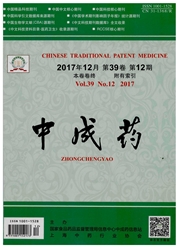

 中文摘要:
中文摘要:
目的研究大川芎方(川芎、天麻)效应组分在硝酸甘油致实验性偏头痛模型大鼠血内、脑内移行成分归属,追溯其从体外-血浆-脑脊液-脑组织的移行趋势。方法以HPLC-DAD为研究手段,建立大川芎方效应组分体内外指纹图谱,并与9个对照品进行成分确认。结果确定大川芎方效应组分中源自于川芎的成分追溯为:体外(20个)-血浆(9个)-脑脊液(6个)-脑组织(5个);确认的入脑成分为阿魏酸、洋川芎内酯I、洋川芎内酯H;源自于天麻的成分追溯为:体外(21个)-血浆(4个)-脑脊液(3个)-脑组织(1个),确认的人脑成分为天麻素、天麻苷元。结论该结果可确立大川芎方的入脑成分,为准确阐明大川芎方治疗偏头痛的药效物质基础提供依据。
 英文摘要:
英文摘要:
AIM To study the attribution of characteristic effective ingredients of Dachuanxiong Decoction ( Li- gustici chuangxiong rhizome , Gastrodiae rhizome) (DCXD , and trace back the migratory pathways from in vitro- plasma-cerebrospinal fluid-brain tissue in experimental rats migraine model induced by nitroglycerin. METHODS The HPLC-DAD was used as the analytic methed to establish in vitro and in vivo fingerprint chromatograms of DCXD, and nine constituents were confirmed. RESULTS The in vitro (20 constituents) -plasma (9) -cerebro- spinal fluid (6) -brain tissue (5) could date back to Ligustici chuangxiong rhizome and had been verified that the ingredients absorbed into brain were ferulic acid, senkyunolide I and senkyunolide H (C15). Meanwhile in vitro (21 constituents) -plasma (4) -cerebrospinal fluid (3) -brain tissue (1) could date back to Gastradine rhizome. And it was confirmed that the ingredients brought into the brain were gastrodin and 4-hydroxyphenethyl alcohol. CONCLUSION The findings could provide the useful information for the determination of bioactive substances of DCXD which is used to treating migraine.
 同期刊论文项目
同期刊论文项目
 同项目期刊论文
同项目期刊论文
 期刊信息
期刊信息
